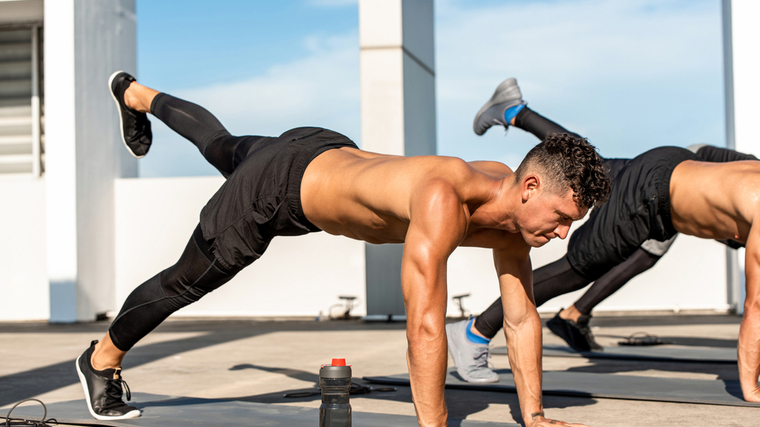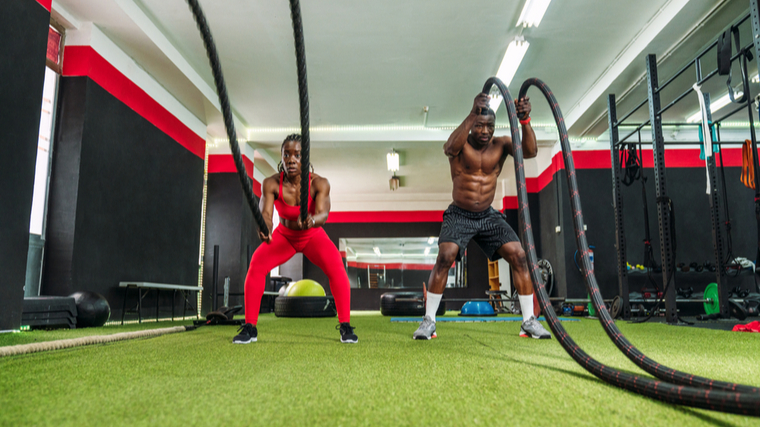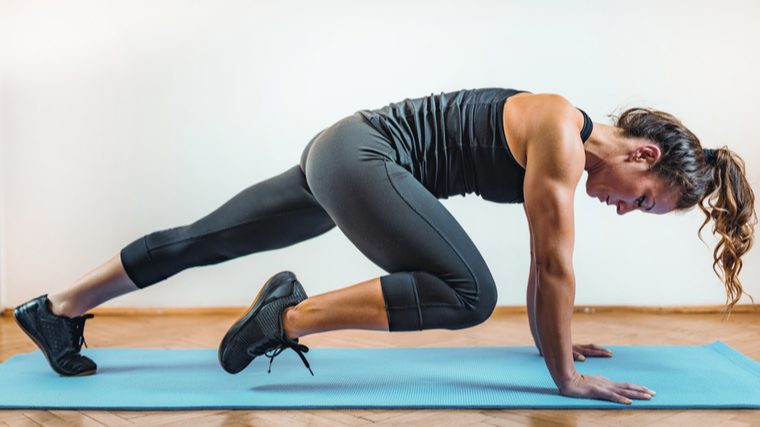The lifting platform is your happy place. Heavy doubles and triples are what make you want to get up in the morning even though your bed is super comfy. But when anyone comes near you with anything that will make you more winded than you get after a set of five squats, you suddenly never want to see the inside of a gym again. If you love lifting but the idea of cardio makes your heart thump with nerves instead of excitement, high-intensity interval training (HIIT) might be just what you need to bridge the gap.
HIIT workouts use short intervals of intense work to help you up the ante of your training without dragging the process out. You’ll work as hard as you can — usually with a full-body, explosive movement like a burpee, box jump, or heavy kettlebell swings — for a short interval. Then, you’ll rest and do it over again until your session is done.

These kinds of intense workouts are designed to elicit your max effort, so make sure you’re fueled up and ready to go. Expect to sweat a lot and to get a whole lot stronger along the way.
What is High-Intensity Interval Training?
HIIT is a training method where you work as hard as you can at the prescribed exercises during short intervals. Sometimes, an interval will only be 10 seconds long. Other times, an interval will be closer to 30 seconds long. However, you don’t want to work for too long — the idea is to approach HIIT workouts at max intensity. To do this, you need to keep intervals short so that your movements are as safe and effective as possible.
More technically-demanding movements like kettlebell snatches might require longer work periods just to make sure you can get multiple reps in. More intense cardio moves like battle ropes or box jumps might call for shorter intervals to make sure you have time to recover properly and maintain good form. Rest intervals vary depending on your preference, skill level, and the particular workout you’re doing. In total, HIIT workouts often range between five and 20 minutes long.
Benefits of HIIT
HIIT workouts allow you to get in some cardio when you hate running. Plus, they’ll help you get a lot stronger — both mentally and physically.
Improves Cardio Fitness
HIIT is a quick and dirty way to slip some cardiovascular conditioning into your program. But the intense nature of the moves means that HIIT is well-catered to lifters who don’t necessarily want to spend a lot of time breathing heavily.
Adding HIIT to a workout program for just one month has been shown to improve VO2 max — an indicator of cardiovascular fitness — when people work at intervals that are less than 30 seconds long for a total of five minutes. (1)

Before you scoff that you hate cardio, remember that HIIT taps into the same anaerobic energy systems that you need to perform those heavy triples that you love so much. The anaerobic “let’s-put-in-all-our-effort” energy systems that you train during HIIT sessions — the phosphagen system, which produces ATP to fuel your sessions — will help you perform better in the short, intense sets you’re pulling and pushing on the platform.
Boosts Confidence
There’s nothing quite like the feeling of surviving a tough HIIT workout and knowing that you did it. It takes mental grit and determination to keep going through an intense workout, but when you complete it, you stand to gain a lot of confidence. Sometimes, when you do have to stop or modify the workout in the middle of your session, that can boost your confidence, too. You’re demonstrating that you know your body and your limits, and you’ll be stronger the next time for it.
That means that you need to choose HIIT workouts that are right for your body. It can be extremely demoralizing to attend a group fitness class or follow along with a YouTube workout that wasn’t designed with your body in mind. If you spend the entire session trying desperately to keep up, it’s not going to do your mind or body much good. But if you define what is high intensity for yourself and do your workout accordingly, you’re more likely to have a positive experience for yourself.
Build Endurance (And Get Stronger)
HIIT workouts can make you mentally stronger, but they’re also going to help you get physically stronger, too. No, you’re not going to be lifting max weights with HIIT. But you will be getting stronger through building muscular endurance. Even short intervals will often have you performing upwards of 15, 20, or more reps — that’s sure to boost your endurance.
Sure, during HIIT workouts, you often have to reduce the weight significantly so you can complete your intervals safely and effectively. But moving huge weights isn’t the only way to get stronger. By focusing on endurance during these workouts, you’re training your muscles (and cardio system) to increase your work capacity — the amount of work you can do in a given amount of time.

Increase Work Capacity and Improve Recovery
As your work capacity increases, you’re going to be able to safely add more volume to your routine. You’ll be able to recover more quickly because your body will acclimate to increased work loads. And when you can train with more volume and recover better, you have a broader base from which to gradually increase the weight and lift heavier and heavier. So even if your ultimate goal is to get maximally strong, HIIT can build your endurance — with even short intervals often including more than 20 reps — as a stepping stone to getting there.
How Do You Do HIIT?
Your HIIT workouts don’t have to be long to be effective. Intervals shorter than 30 seconds in sessions lasting no longer than five minutes have been shown to improve cardiovascular fitness. (1)
During HIIT workouts, you will often rest longer than you’re working — but that doesn’t mean it’s not effective. When performed four times a week, 20-minute sessions of 10:50 work:rest intervals (10 seconds work, 50 seconds rest) have been shown to increase cardiovascular health indicators more than 40-minute sessions of continuous cycling. (2)
In more advanced workouts, you might have a work:rest ratio of 1:1 or even 2:1 — so if you’re working for 10 seconds, you’ll rest for 10. Or if you’re working for 30 seconds, you’ll rest for 15.

Overall, your session could consist of five minutes or 20 minutes of stop-and-go intensity. Either way, keep your intervals short enough that you can maintain a high intensity. You want to be going pretty much at full effort — that’s why even 10-second work windows will feel so long.
If you feel like you’re not going to be able to complete the workout as written but want to keep going, consider using less weight or otherwise modifying the movements to suit your needs. You can also adjust the work:rest ratio as needed to work shorter and rest longer until you build more endurance.
Sample HIIT Workout
Want a quick, six-minute HIIT workout? This example only uses two pieces of equipment — kettlebells and battle ropes — so that you don’t have to hoard all the equipment and space your gym has to offer. Just bring the kettlebells over by the ropes, and remember that it will all be over in a few minutes.
Don’t forget to use workout modifications when you need them, and listen to your body throughout the session.
- Battle Rope: 15 seconds.
- Rest: 15 seconds.
- Battle Rope: 15 seconds.
- Rest: 15 seconds.
- Double Kettlebell Swing: 30 seconds.
- Rest: 30 seconds.
- Repeat circuit three times.
Who Should Do HIIT?
If you want to give HIIT a try, you might feel less demoralized by the process if you have some lifting experience and a basic level of cardiovascular health to work with. If not, choose movements you’re familiar with and that you enjoy doing. Make sure your form is on point, and don’t be afraid to customize a HIIT workout to make it your own.
Strength Athletes
When preparing for competition, strength athletes like powerlifters and Olympic weightlifters generally want to stick as close as possible to competition lifts. But in the off-season, conditioning can be a very important part of improving your strength game. Try integrating one or two HIIT workouts a week — perhaps as workout finishers — and make sure you’re recovering well enough to perform your main lifts at high levels in the following days.
CrossFitters and Functional Fitness Athletes
Workouts where you have to push full-tilt are CrossFitters’ proverbial bread and butter. HIIT workouts can accompany your WOD nicely to supplement the gains you’re already making.
Perhaps you want to design HIIT workouts around moves that you’re not getting a lot of in other parts of your program. Consider sled pushes and pulls, as well as battle rope moves, that may be less likely to show up in your workout of the day.
Regular Gymgoers
Not competing in anything? No problem. HIIT can still help you get you where you want to go. Maybe you’re looking to be stronger or to improve your cardio health without a treadmill. Either way, HIIT workouts can help you get closer to your fitness goals. You might need to start slowly, and that’s okay. Make sure you’re meeting yourself where you’re at and keeping your form solid.
When Should You Do HIIT?
Figuring out how to integrate HIIT into your lifting program can be a bit tricky. You don’t want to overload your body so much that you can’t recover in time for your next heavy training session. But it’s well worth the effort if you need a jolt of cardio in your life. Depending on what the rest of your program looks like and what kind of training split you have, you can integrate HIIT anywhere from one to four times a week.
People often tack HIIT workouts on at the end of their lifting session as a finisher. This can be effective because it won’t take energy and mental focus away from the day’s big lift. It also means that you’ll be recovering in the same bout.

By performing a lower-body HIIT workout on the same day that you squat, your lower body will be recovering all together so you’ll be ready for your next leg day. If you separate HIIT too far from your regular lifting sessions, you might need twice the recovery time. That said, let some time pass between your heavy working sets and your HIIT session to avoid overreaching and potentially hurting yourself.
A Brief History of HIIT
HIIT has been around for decades, with different athletes and strength scholars developing different protocols to work hard and fast, then rest and repeat.
Many lifters are familiar with the Tabata style of training. It was named in 1996 for the Ritsumeikan University professor, Izumi Tabata, who studied a type of high-intensity training featuring 20 seconds of extremely intense work followed by 10 seconds of rest. In 2004, Jorge Zuninga coined the Zuninga method of HIIT, which features 10 rounds 30 seconds of hard work followed by 30 seconds of rest. Trainers and researchers alike have come up with and spread their own versions of HIIT. This style of training has inspired a movement of boutique studios, ranging from Barry’s Bootcamp and F45 to Orange Theory.
Go Forth and HIIT It
By training as hard as you can during specific intervals, you’ll train your body and mind to leave it all on the platform. HIIT cultivates the kind of mentality and energy that you need to be a successful lifter. Plus, it’ll take care of your cardiovascular fitness needs. So really, what’s stopping you from diving in?
References
- Wen D, Utesch T, Wu J, Robertson S, Liu J, Hu G, Chen H. Effects of different protocols of high intensity interval training for VO2max improvements in adults: A meta-analysis of randomised controlled trials. J Sci Med Sport. 2019 Aug;22(8):941-947.
- Alansare A, Alford K, Lee S, Church T, Jung HC. The Effects of High-Intensity Interval Training vs. Moderate-Intensity Continuous Training on Heart Rate Variability in Physically Inactive Adults. Int J Environ Res Public Health. 2018;15(7):1508.
Featured Image: koldo_studio / Shutterstock